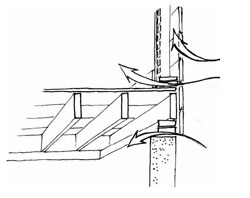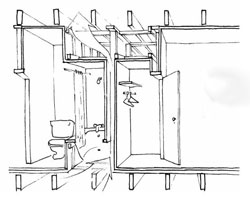Find and Seal Air Leaks
Hidden air leaks cause some of the largest heat losses in older homes. In the average home, small openings in the outer shell of a house account for almost 30% of total heat lost. Common air leakage sites are listed below:
- Plumbing penetrations through insulated floors and ceilings
- Chimney penetrations through insulated ceilings and exterior walls
- Along the sill plate and band joist at the top of foundation walls
- Fireplace dampers
- Attic access hatches
- The tops of interior partition walls where they intersect with the attic space
- Recessed lights and fans in insulated ceilings
- Wiring penetrations through insulated floors, ceilings, and walls
- Missing plaster
- Electrical outlets and switches, especially on exterior walls
- Window, door, and baseboard moldings
- Dropped ceilings above bathtubs and cabinets
- Kneewalls in finished attics, especially at access doors and built-in cabinets and bureaus.
The appropriate material for sealing these hidden air leaks depends on the size of the gaps and where they are located. Caulk is best for cracks and gaps less than about 1⁄4" wide. In choosing caulks, read the label carefully to make sure that the caulk is suitable for the material to be sealed. Look for caulks that remain flexible over a 20-year lifetime. If the caulked joint will be visible, choose a paintable caulk or one that is the right color. In general, you should avoid the cheapest caulks, because they probably won’t hold up well. Expanding foam sealant is an excellent material to use for sealing larger cracks and holes that are protected from sunlight and moisture. One-part polyurethane foam is commonly available in hardware and building supply stores. Today’s products are safe for atmospheric ozone.
Watch for hidden air leaks around pipes, and seal them up

A tremendous amount of heat can escape around the chimney if it isn't properly sealed.
Backer rod or crack filler is a flexible foam material, usually round in cross-section (1⁄4” to 1” in diameter), and sold in long coils. Use it for sealing large cracks and to provide a backing in very deep cracks that are to be sealed with caulk.
Use rigid foam insulation for sealing very large openings such as plumbing chases and attic hatch covers. Fiberglass insulation can also be used for sealing large holes, but it will work better if wrapped in plastic or stuffed in plastic bags, because air can leak through exposed fiberglass. Don’t use plastic in places where high temperatures may be reached, and always wear gloves and a dust mask when working with fiberglass.
Sheets of polyethylene can be taped over large holes to block airflow in some situations, but this is usually a fairly temporary measure, since the polyethylene may disintegrate over time if not protected. Specialized materials such as metal flashing and high-temperature silicone sealants may be required for sealing around chimneys and flue pipes. Check with your building inspector or fire marshal if unsure about fire-safe details in these locations.




